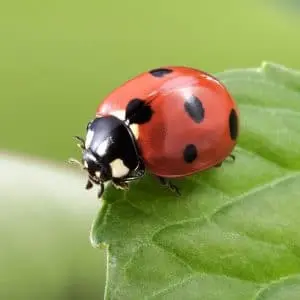Considered a symbol of luck around the world, ladybugs are often described as cute, harmless, and even helpful little insects. This is somewhat true, but before you nod your head in agreement, there are some things you should know about these tiny button-like bugs.
Also known as lady beetles or ladybird beetles, some ladybugs are native to our country. But multicolored Asian lady beetles (Harmonia axyridis) were imported from overseas to help control pests. These ladybugs first arrived in the early 1900s to feed on pests that were destroying crops. But their population quickly expanded all over the United States, making many people question if Asian lady beetles are good or bad.
Two of a Kind? Identifying Ladybugs
Native ladybugs and their Asian cousins look a lot alike. Both have tiny, domed bodies that range in color from light yellow to orange to dark red. There are some differences. The Asian lady beetle is slightly larger, darker in color (usually dark burnt orange or dark red), and has more spots (up to 19) than the native beetles. Also, these imported insects have a white mark behind the head with a black “M” shape in it. The most important difference between the two, however, is that Asian lady beetles are aggressive nuisances that sometimes even bite.
Are Asian Lady Beetles Good or Bad?
Basically, ladybugs are beneficial predators that feed on plant pests like aphids, mites, and scale insects. Farmers and gardeners consider them “lucky” for that reason. However, homeowners feel differently.
In the fall, Asian lady beetles gather in swarms on the sunny side of buildings or homes in search of places to overwinter. Structures that are light in color with dark or contrasting trim draw attention from these insects, as well as homes located near woods or fields. Structures in need of repair fall prey most often. Cracks in foundation, gaps between siding, windowsills, and door frames, and torn screens provide easy entry for the bugs.
Once inside, the swarm is a problem. Asian lady beetles release pheromones in the locations they like so that the next generation can find the same spot the following year. This is why it is difficult to get rid of these uninvited guests permanently. Also, when they are disturbed, the beetles secrete an odorous yellowish fluid that can stain walls or other surfaces. These aggressive insects bite, too, and sometimes even cause allergic reactions.
Preventing an Asian Lady Beetle Invasion
The most effective way to manage beetles is prevention. They can fit through very tiny openings, so here are some suggestions to stop them from entering your home.
- Repair or replace damaged screens in doors and windows.
- Seal or caulk cracks in foundations, gaps in siding, and any other crevices.
- Make sure the weather stripping on any door is secure.
- Patch holes in interior walls.
- Check openings for pipes, vents, and utility wires, and make sure they are properly sealed.
If these steps are not enough, hire a professional to do an inspection of your home to find the points of entry. Professionals can also create a barrier outside your home using an insecticide. These applications will need to be repeated periodically and work best when applied before fall arrives.
Getting Beetles out of Your Home
Prevention is your best bet, but what if they are already inside? Squashing or swatting the beetles causes them to secrete the smelly fluid, so you’ll want a gentle approach. Your vacuum is a good weapon of choice, but with a slight modification. Attach a knee-high stocking to the inside of a vacuum hose using a rubber band. This way, the bugs get sucked into the soft stocking without too much disturbance and can be disposed of before they secrete the fluid.
Contact Free Spray Lawn Care today at 419-529-5296 and let us help you keep unwanted pests from invading your home.



Comments (0)
Thanks for your comment!
Thanks for your feedback! Your comments have been successfully submitted! Please note, all comments require admin approval prior to display.
Error submitting comment!
There is a problem with your comment, please see below and try again.